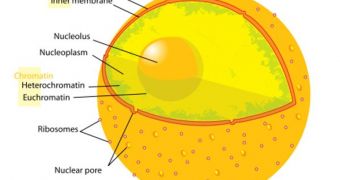For a long time, scientists have tried to understand the exact construction and operating mechanism of complex protein structures inside cellular nuclei called nuclear pore complexes (NPC). These intricate structures, made up of as much as 30 individual proteins, are extremely large, and yet remained impenetrable to viewing techniques for many years. Now, a new series of studies, from researchers at the Rockefeller University’s (RU) Laboratory of Cell Biology, finally begins to shed some light on the elusive formations, ScienceDaily reports.
In order to maintain their integrity, cells are careful about what they let inside their nuclei. This is where all the genetic material is stored, and, if intruders make it through, then viruses and other pathogens can gain a foothold in the organisms. This may start a chain of mutations that could lead to severe diseases such as cancer. NPC are, in fact, transport machines, which only bind to selected series of chemical compounds. These chemicals are “known” to be safe, so the NPC carry them.
The RU investigation has now revealed the make-up of one of these proteins, as well as the interactions it has with a partner. The study is the first to prove a theory that holds that ring-like structures exist within the pores, around each opening they have. The experts believe that further analyses of this complex may lead them to a better understanding of how NPC came to evolve billions of years ago, and how this little-understood mechanism managed to make multicellular life as we know it possible.
The recently analyzed portion of NPC is the Nup84 complex, an Y-shaped element. Martin Kampmann, an RU expert working in Howard Hughes Medical Institute investigator Gunter Blobel's lab, has recently managed to model this structure in 3D. In charge of the latest studies have been RU Laboratory of Cell Biology Postdoctoral Associate Hyuk-Soo Seo and Research Associate Andre Hoelz. The newly found, nucleoporin-class protein has been dubbed Nup120. It is always attached through an elastic connection to Nup133, a partner protein in the same complex.
“It’s a very nice correlation from the structure to the function. It’s the first example where we can really pin down how the [Nup84] complexes arrange with each other, and what we believe we see is a flexible ring that could expand and contract to import and export large molecules,” Hoelz says. Details of the research can be found in the latest issue of the journal Proceedings of the National Academy of Sciences (PNAS).

 14 DAY TRIAL //
14 DAY TRIAL //